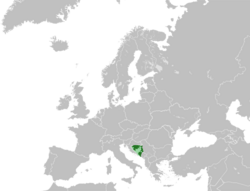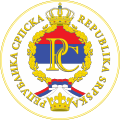
Back Serwiese Republiek Afrikaans Republica Serbia AN جمهورية صرب البوسنة Arabic جمهورية صرب البوسنه ARZ República Serbia AST Serb Respublikası Azerbaijani Серб Республикаһы Bashkir Рэспубліка Сербская Byelorussian Рэспубліка Сэрбская BE-X-OLD Република Сръбска Bulgarian
Republika Srpska Република Српска | |
|---|---|
| Anthem: Moja Republika | |
 Republika Srpska (red) in Bosnia and Herzegovina | |
 Location of Republika Srpska in Europe | |
| Proclaimed | 9 January 1992 |
| Recognised as part of Bosnia and Herzegovina | 14 December 1995 |
| Capital | Istočno Sarajevo (de iure)Banja Luka (de facto) |
| Largest city | Banja Luka |
| Official languages | |
| Ethnic groups | |
| Religion |
|
| Government | Federated state |
| Milorad Dodik | |
| Radovan Višković | |
| Nenad Stevandić | |
| Legislature | National Assembly |
| Area | |
• Total | 24,641 km2 (9,514 sq mi) |
| Population | |
• 2023 estimate | 1,114,819 |
• 2013 census | 1,170,342 |
• Density | 45.2/km2 (117.1/sq mi) |
| GDP (nominal) | 2024 estimate |
• Total | $9.429 billion |
• Per capita | $8,458 |
| HDI (2022) | high |
| Currency | Convertible mark (BAM) |
| Time zone | UTC+02:00 (+01:00) |
| Date format | dd/mm/yyyy |
| Driving side | Right |
| Calling code | +387 |
| ISO 3166 code | BA-SRP |
| aThe Constitution of Republika Srpska avoids naming "Serbian, Bosnian, and Croatian", instead listing them as "the language of the Serb people, the language of the Bosniak people and the language of the Croat people" due to the ongoing debate over the separation of these languages.[2] | |
Republika Srpska (Serbian Cyrillic: Република Српска, pronounced [repǔblika sr̩̂pskaː] ⓘ; also referred to as the Republic of Srpska or Serb Republic) is one of the two entities within Bosnia and Herzegovina, the other being the Federation of Bosnia and Herzegovina. Situated in the northern and eastern regions of the country, it recorded a population of 1,228,423 in the 2013 census. Its largest city and administrative hub is Banja Luka, located on the banks of the Vrbas River.
Republika Srpska was established in 1992 at the onset of the Bosnian War with the stated purpose of safeguarding the interests of the Serbs of Bosnia and Herzegovina. During the conflict, the expulsion of the majority of Croats and Bosniaks from territories controlled by Republika Srpska occurred, while the majority of Serbs were displaced or expelled from the Federation of Bosnia and Herzegovina to Republika Srpska. The 1995 Dayton Agreement created Republika Srpska as one of Bosnia and Herzegovina's two constituent entities. Today, it is inhabited by the Serb population of the country.
The entity operates under a parliamentary system, with legislative power vested in the National Assembly, which comprises 83 seats. While Republika Srpska is relatively centralized, it is administratively divided into 64 municipalities, known as opštine (singular: opština).[3] The current legislative term marks the tenth session since its inception.
- ^ "Sub-national HDI – Area Database – Global Data Lab". hdi.globaldatalab.org. Archived from the original on 23 September 2018. Retrieved 3 December 2018.
- ^ "Decision on Constitutional Amendments in Republika Srpska". Office of the High Representative. Archived from the original on 18 January 2012. Retrieved 3 June 2010.
- ^ "Bosnia-Herzegovina profile". BBC News. Archived from the original on 11 April 2013. Retrieved 14 April 2013.
© MMXXIII Rich X Search. We shall prevail. All rights reserved. Rich X Search

